2015数据库系统期末试题及答案
数据库期末考试试题及答案

数据库期末考试试题及答案一、名词解释(每小题2分,共10分)1. 数据库(Database)2. 数据模型(Data Model)3. 表(Table)4. 字段(Field)5. 记录(Record)6. 主键(Primary Key)7. 外键(Foreign Key)8. 索引(Index)9. 视图(View)10. 存储过程(Stored Procedure)二、选择题(每小题2分,共20分)1. 下列哪个是关系型数据库管理系统?A. OracleB. MyBatisC. MongoDBD. Redis2. 在数据库中,哪个字段用于唯一标识一条记录?A. 字段名B. 数据类型C. 主键D. 索引3. 以下哪个不属于数据库的基本操作?A. 插入B. 删除C. 修改D. 格式化4. 下列哪个SQL语句用于创建表?A. SELECTB. INSERTC. CREATE TABLED. UPDATE5. 在SQL中,哪个关键字用于删除表?A. DROP TABLEB. DELETEC. ALTER TABLED. TRUNCATE TABLE6. 下列哪个SQL语句用于查询所有字段?A. SELECT FROM table_nameB. SELECT table_name FROMC. SELECT FROM table_nameD. SELECT table_name7. 以下哪个函数用于计算两个日期之间的差值?A. DATEDIFFB. TIMESTAMPDIFFC. DATE_ADDD. DATE_SUB8. 下列哪个SQL语句用于修改表的结构?A. MODIFY TABLEB. ALTER TABLEC. CHANGE TABLED. RENAME TABLE9. 下列哪个关键字用于创建外键约束?A. FOREIGN KEYB. CONSTRAINTC. PRIMARY KEYD. INDEX10. 以下哪个存储过程用于备份数据库?A. BACKUP DATABASEB. RESTORE DATABASEC. CREATE DATABASED. DROP DATABASE三、填空题(每小题2分,共20分)1. 在SQL中,用于插入数据的语句是______。
(完整word版)2015年数据库期末考试试题和答案

试题一一、单项选择题(本大题共20小题,每小题2分,共40分)在每小题列出的四个备选项中只有一个是符合题目要求的,请将其代码填写在题后的括号内。
错选、多选或未选均无分.1. 数据库系统的核心是( B )A.数据库B.数据库管理系统C.数据模型D.软件工具2。
下列四项中,不属于数据库系统的特点的是(C )A.数据结构化B.数据由DBMS统一管理和控制C.数据冗余度大D.数据独立性高3.概念模型是现实世界的第一层抽象,这一类模型中最著名的模型是( D )A.层次模型B.关系模型C.网状模型D.实体—联系模型4。
数据的物理独立性是指( C )A.数据库与数据库管理系统相互独立B.用户程序与数据库管理系统相互独立C.用户的应用程序与存储在磁盘上数据库中的数据是相互独立的D.应用程序与数据库中数据的逻辑结构是相互独立的5.要保证数据库的逻辑数据独立性,需要修改的是( A )A.模式与外模式之间的映象B.模式与内模式之间的映象C.模式D.三级模式6.关系数据模型的基本数据结构是(D )A.树B.图C.索引D.关系7.有一名为“列车运营"实体,含有:车次、日期、实际发车时间、实际抵达时间、情况摘要等属性,该实体主码是( C )A.车次B.日期C.车次+日期D.车次+情况摘要8.己知关系R和S,R∩S等价于( B )A。
(R—S)-S B. S-(S—R)C。
(S-R)-R D。
S—(R—S)9.学校数据库中有学生和宿舍两个关系:学生(学号,姓名)和宿舍(楼名,房间号,床位号,学号)假设有的学生不住宿,床位也可能空闲。
如果要列出所有学生住宿和宿舍分配的情况,包括没有住宿的学生和空闲的床位,则应执行( A )A。
全外联接B. 左外联接C. 右外联接D。
自然联接10.用下面的T-SQL语句建立一个基本表:CREATE TABLE Student(Sno CHAR(4)PRIMARY KEY,Sname CHAR(8) NOT NULL,Sex CHAR(2),Age INT)可以插入到表中的元组是( D )A。
数据库系统期末考试试卷-答案
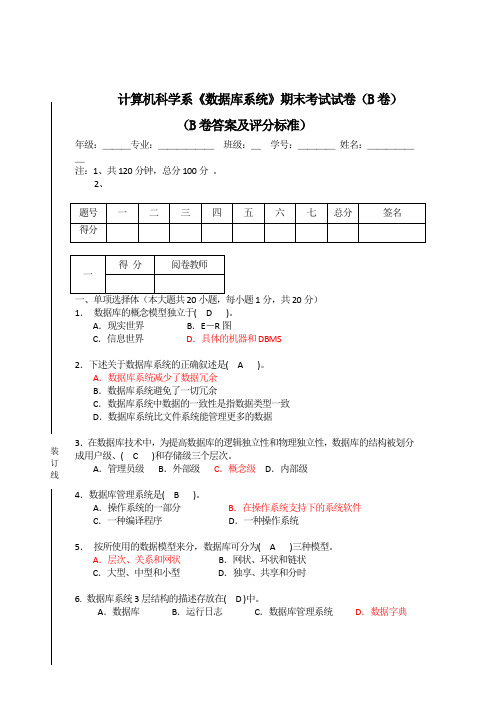
计算机科学系《数据库系统》期末考试试卷(B 卷)(B 卷答案及评分标准)年级:___专业:______ 班级:_ 学号:____ 姓名:______注:1、共120分钟,总分100分 。
2、1分,共20分) 1. 数据库的概念模型独立于( D )。
A .现实世界B .E -R 图C .信息世界D .具体的机器和DBMS2.下述关于数据库系统的正确叙述是( A )。
A .数据库系统减少了数据冗余B .数据库系统避免了一切冗余C .数据库系统中数据的一致性是指数据类型一致D .数据库系统比文件系统能管理更多的数据 3.在数据库技术中,为提高数据库的逻辑独立性和物理独立性,数据库的结构被划分成用户级、( C )和存储级三个层次。
A .管理员级B .外部级C .概念级D .内部级4.数据库管理系统是(B )。
A .操作系统的一部分B .在操作系统支持下的系统软件C .一种编译程序D .一种操作系统5. 按所使用的数据模型来分,数据库可分为( A )三种模型。
A .层次、关系和网状B .网状、环状和链状C .大型、中型和小型D .独享、共享和分时6. 数据库系统3层结构的描述存放在( D )中。
A .数据库B .运行日志C .数据库管理系统D .数据字典7.在数据库的三级模式结构中,描述数据库中全体数据的全局逻辑结构和特征的是( D )。
A.外模式B.内模式C.存储模式D.逻辑模式8.数据库管理系统能实现对数据库中数据的查询、插入、修改和删除等操作.这种功能称为( C )。
A.数据定义功能B.数据管理功能C.数据操纵功能D.数据控制功能9. ( A )是数据库系统的基础。
A.数据模型B.数据库C.数据库管理系统D.数据库管理员10. 在数据库技术中,实体-联系模型是一种( D )。
A. 逻辑数据模型B. 物理数据模型C. 结构数据模型D. 概念数据模型11. 在关系数据库设计中,设计关系模式是( C )的任务。
数据库系统概论期末试题及答案(整理版)
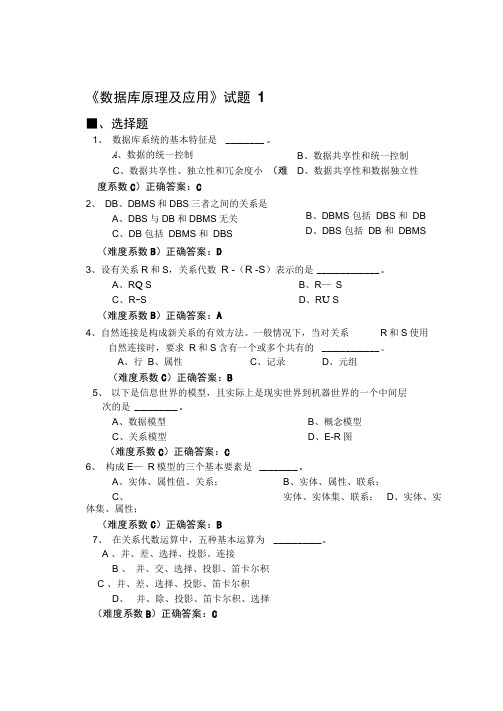
《数据库原理及应用》试题 1■、选择题1、 数据库系统的基本特征是 ________ 。
A 、数据的统一控制C 、数据共享性、独立性和冗余度小 (难度系数C )正确答案:C2、 DB 、DBMS 和DBS 三者之间的关系是A 、DBS 与DB 和DBMS 无关C 、DB 包括 DBMS 和 DBS(难度系数B )正确答案:D3、设有关系R 和S ,关系代数 R -(R -S )表示的是 _____________ 。
A 、R Q SB 、R — SC 、R -SD 、R U S(难度系数B )正确答案:A4、自然连接是构成新关系的有效方法。
一般情况下,当对关系R 和S 使用自然连接时,要求 R 和S 含有一个或多个共有的 ____________ 。
A 、行B 、属性C 、记录D 、元组(难度系数C )正确答案:B5、 以下是信息世界的模型,且实际上是现实世界到机器世界的一个中间层 次的是 _________ 。
A 、数据模型 B 、概念模型 C 、关系模型D 、E-R 图(难度系数C )正确答案:C6、 构成E — R 模型的三个基本要素是 ________ 。
A 、实体、属性值、关系;B 、实体、属性、联系;C 、 实体、实体集、联系;D 、实体、实体集、属性;(难度系数C )正确答案:B7、 在关系代数运算中,五种基本运算为 __________ 。
A 、并、差、选择、投影、连接 B 、 并、交、选择、投影、笛卡尔积 C 、并、差、选择、投影、笛卡尔积D 、 并、除、投影、笛卡尔积、选择(难度系数B )正确答案:CB 、数据共享性和统一控制D 、数据共享性和数据独立性B 、DBMS 包括 DBS 和 DB D 、DBS 包括 DB 和 DBMS&在下列关于规范化理论的叙述中,不正确的是_____________ 。
A、任何一个关系模式一定有键。
SDETP char(12) check (SDEPT IN( IS','MA','CS')))13、允许取空值但不允许出现重复值的约束是 ____________A 、NULLB 、PRIMARY KEYC 、UNIQUED 、FOREIGN KEY(难度系数B )正确答案:CA 、 ( 'T0203' ,'刘刚’, NULL , NULL , IS 'B 、 ( NULL ,王芳’, '女’,‘ 1200',‘ CS ')C 、 ( 'T0111' ,NULL ,'男’,23,‘ MA ') D 、( 'T0101' ,'李华’ ,男,2100, ‘ EN ' )o可以插入到Teacher 表中的元组是(难度系数A )正确答案:A12、SQL 语言中,条件年龄 BETWEEN 18 AND 30表示年龄在18至30之间,B 、 任何一个包含两个属性的关系模式一定满足C 、 任何一个包含两个属性的关系模式一定满足D 任何一个包含三个属性的关系模式一定满足(难度系数B )正确答案:D9、 设有关系模式 R(A,B,C)和S(C,D)。
《数据库应用技术》2015期末试题及答案

《数据库应用技术》2015期末试题及答案
《数据库应用技术》2015期末试题及答案
一、单项选择题(每题只有一个答案是正确的。
每题2分,共20题.
40分)
1.在数据管理技术发展过程的几个阶段中,数据独立性最高的阶段是( )。
A.人工管理阶段 B.文件管理阶段
C.数据项管理阶段 D.数据库管理阶段
2.关于模式的正确描述是( )。
A.内模式可以有多个 B.外模式只有一个
C.不同用户的外模式都是相同的 D.模式只有一个
3.下列属于数据库模式范畴的是( )。
A.索引按照什么方式组织 B.数据是否经过压缩
C.描述数据库中数据的逻辑结构 D.不同的用户可以看到不同的数据4。
数据库管理系统常见的数据模型有( )。
A.网状、关系和语义.B.层次、关系和网状
C.环状、层次和关系 D.网状、链状和层次
5.在生产商关系中,能够成为主关键字(或称主码)的属性是( )。
A.生产商名称 B.生产商编号
C.生产商所在地 D.生产商电话
6.为数据库系统的临时表提供工作空间的系统数据库是( )。
A. pubs B.model
C.tempdb D.master。
2015数据库复习题答案

(说明:仅仅代表个人观点,答案正确率为98%,可能会有错的地方,有问题请问度娘)复习参考资料选择题:30分(15题)名词解释:20分(4题)综合题:50分一、选择题:1. 数据库系统是采用了数据库技术的计算机系统,数据库系统由数据库、数据库管理系统、应用系统和(C)。
A. 系统分析员B. 程序员C. 数据库管理员D. 操作员2. 数据库(DB),数据库系统(DBS)和数据库管理系统(DBMS)之间的关系是(A)。
A. DBS包括DB和DBMSB. DBMS包括DB和DBSC. DB包括DBS和DBMSD. DBS就是DB,也就是DBMS3. 下面列出的数据库管理技术发展的三个阶段中,没有专门的软件对数据进行管理的是(D)。
I.人工管理阶段II.文件系统阶段III.数据库阶段A. I 和IIB. 只有IIC. II 和IIID. 只有I4. 下列四项中,不属于数据库系统特点的是(C )。
A. 数据共享B. 数据完整性C. 数据冗余度高D. 数据独立性高5. 数据库系统的数据独立性体现在(B)。
A. 不会因为数据的变化而影响到应用程序B. 不会因为数据存储结构与数据逻辑结构的变化而影响应用程序C. 不会因为存储策略的变化而影响存储结构D. 不会因为某些存储结构的变化而影响其他的存储结构6. 描述数据库全体数据的全局逻辑结构和特性的是(A )。
A. 模式B. 内模式C. 外模式D. 以上三种7. 要保证数据库的数据独立性,需要修改的是(C)。
A. 模式与外模式B. 模式与内模式C. 三级模式之间的两层映射D. 三层模式8. 要保证数据库的逻辑数据独立性,需要修改的是(A)。
A. 模式与外模式之间的映射B. 模式与内模式之间的映射C. 模式D. 三级模式9. 用户或应用程序看到的那部分局部逻辑结构和特征的描述是(C)模式。
A. 模式B. 物理模式C. 子模式D. 内模式10. 下述(D)不是DBA数据库管理员的职责。
四川大学数据库2015年期末试卷和答案

(b)等值连接不把重复属性去掉,而自然连接要把重复属性去掉。
3、为什么将SQL 中的视图称为“虚表”?答:在SQL中创建一个视图时,系统只是将视图的定义存放在数据字典中,并不存储视图对应的数据,在用户使用视图时才去求对应的数据,因此,我们将视图称为“虚表”。
这样处理的目的是为了节约存储空间,因为视图对应的数据都可从相应的基本表中获得。
4、列出3条查询优化的启发式规则。
答:3 条启发式优化规则是:尽可能早地执行选择运算,尽可能早地执行投影运算,把笛卡尔积与附近的一连串选择和投影合并起来做。
5、试叙述“串行调度”与“可串行化调度”的区别。
答:事务的执行次序称为调度。
如果多个事务依次执行,则称为事务的串行调度。
如果利用分时的方法,同时处理多个事务,则称为事务的并发调度。
如果一个并发调度的结果与某一串行调度的执行结果等价,那么这个并发调度称为是可串行化的调度。
三、设计题(共8分)在学术论文完成过程中,一位学者可以撰写多篇论文,一篇论文也可由多位学者合著,每篇论文的作者都有一个排序。
一篇论文只能发表一次,学术刊物的某一辑(卷号、期号)发表多篇论文在。
设学者的属性有:身份证号、姓名、单位、通讯地址;论文的属性有:论文题目、主题、术语;学术刊物的属性有:ISBN号、名称、影响因子。
试完成以下两题:(1)根据这段话的意思,画出其E-R 图。
(4分)(2)将这个E-R 图转换为满足3NF的关系模式,并给出各关系模式中的主码。
(4分)(3)SELECT DISTINCT X.SnoFROM SC X, SC YWHERE X.Sno=Y.Sno AND o!=o;(4)SELECT DISTINCT SnoFROM SC XWHERE NOT EXISTS(SELECT *FROM CWHERE Teacher='张' AND NOT EXISTS(SELECT *FROM SC YWHERE Y.Sno=X.Sno AND o=o));五、查询优化(共10分)给定“学生-课程”数据库的关系模式如三大题4小题:S(Sno,Sname,Sgender,Sage)SC(Sno,Cno,Grade)C(Cno,Cname,Teacher)对查询“检索选修“信息系统”课程的学生姓名与年龄。
数据库期末考试试题及答案
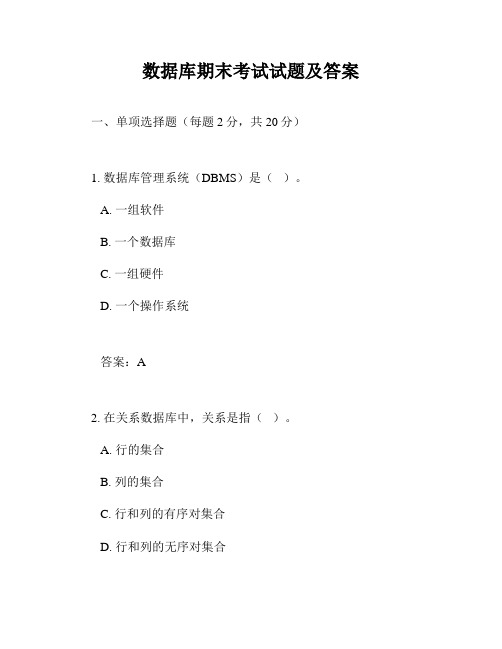
数据库期末考试试题及答案一、单项选择题(每题2分,共20分)1. 数据库管理系统(DBMS)是()。
A. 一组软件B. 一个数据库C. 一组硬件D. 一个操作系统答案:A2. 在关系数据库中,关系是指()。
A. 行的集合B. 列的集合C. 行和列的有序对集合D. 行和列的无序对集合答案:C3. SQL是()。
A. 数据定义语言B. 数据控制语言C. 数据操纵语言D. 结构化查询语言答案:D4. 数据库系统的核心是()。
A. 数据模型B. 数据库管理系统C. 数据库D. 应用程序答案:C5. 数据库设计中,视图设计属于()。
A. 概念性设计B. 逻辑设计C. 物理设计D. 实体-关系模型设计答案:B6. 在关系数据库中,一个关系至少有一个候选键,一个候选键可以有()个属性。
A. 一个B. 多个C. 零个D. 任意个答案:B7. 数据库管理系统能提供数据的()。
A. 物理独立性B. 逻辑独立性C. 数据独立性D. 以上都是答案:D8. 数据库中,存储数据的基本单位是()。
A. 记录B. 字段C. 表D. 文件答案:C9. 数据库系统与文件系统相比,数据库系统能够提供()。
A. 数据共享B. 数据独立性C. 数据完整性D. 以上都是答案:D10. 在数据库中,数据的完整性约束不包括()。
A. 实体完整性B. 参照完整性C. 用户定义的完整性D. 数据冗余答案:D二、填空题(每题2分,共20分)1. 数据库系统由数据库、数据库管理系统和_________组成。
答案:数据库应用程序2. 数据库系统的核心是_________。
答案:数据库3. 数据库管理系统的主要功能包括数据定义、数据操纵、数据控制和_________。
答案:事务管理4. 在关系数据库中,关系模式的每一个分量称为_________。
答案:属性5. 数据库设计分为概念性设计、_________设计和物理设计三个阶段。
答案:逻辑6. 在数据库中,_________是指关系中的列。
2015年数据结构期末考试题及答案,推荐文档(2021年整理)
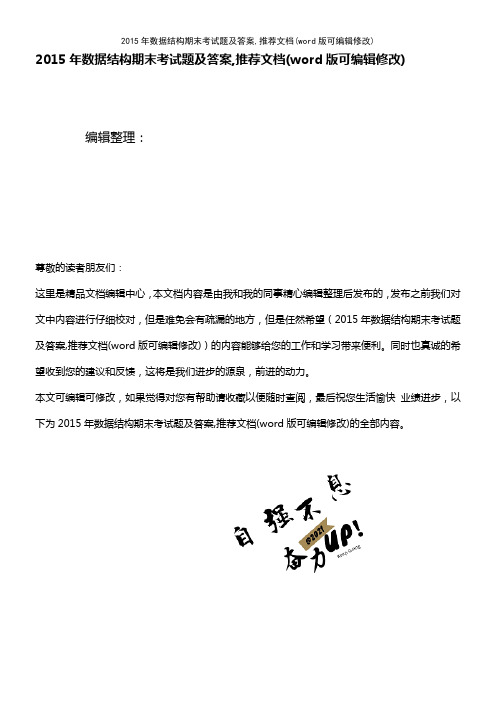
2015年数据结构期末考试题及答案,推荐文档(word版可编辑修改) 编辑整理:尊敬的读者朋友们:这里是精品文档编辑中心,本文档内容是由我和我的同事精心编辑整理后发布的,发布之前我们对文中内容进行仔细校对,但是难免会有疏漏的地方,但是任然希望(2015年数据结构期末考试题及答案,推荐文档(word版可编辑修改))的内容能够给您的工作和学习带来便利。
同时也真诚的希望收到您的建议和反馈,这将是我们进步的源泉,前进的动力。
本文可编辑可修改,如果觉得对您有帮助请收藏以便随时查阅,最后祝您生活愉快业绩进步,以下为2015年数据结构期末考试题及答案,推荐文档(word版可编辑修改)的全部内容。
2012年数据结构期末考试题及答案一、选择题1.在数据结构中,从逻辑上可以把数据结构分为 C 。
A.动态结构和静态结构 B.紧凑结构和非紧凑结构C.线性结构和非线性结构 D.内部结构和外部结构2.数据结构在计算机内存中的表示是指 A 。
A.数据的存储结构B.数据结构C.数据的逻辑结构 D.数据元素之间的关系3.在数据结构中,与所使用的计算机无关的是数据的 A 结构。
A.逻辑B.存储C.逻辑和存储D.物理4.在存储数据时,通常不仅要存储各数据元素的值,而且还要存储 C .A.数据的处理方法B.数据元素的类型C.数据元素之间的关系D.数据的存储方法5.在决定选取何种存储结构时,一般不考虑 A 。
A.各结点的值如何B.结点个数的多少C.对数据有哪些运算D.所用的编程语言实现这种结构是否方便.6.以下说法正确的是 D 。
A.数据项是数据的基本单位B.数据元素是数据的最小单位C.数据结构是带结构的数据项的集合D.一些表面上很不相同的数据可以有相同的逻辑结构7.算法分析的目的是 C ,算法分析的两个主要方面是 A .(1)A.找出数据结构的合理性 B.研究算法中的输入和输出的关系C.分析算法的效率以求改进 C.分析算法的易读性和文档性(2)A.空间复杂度和时间复杂度 B.正确性和简明性C.可读性和文档性 D.数据复杂性和程序复杂性8.下面程序段的时间复杂度是O(n2) 。
数据库期末考试试题及答案
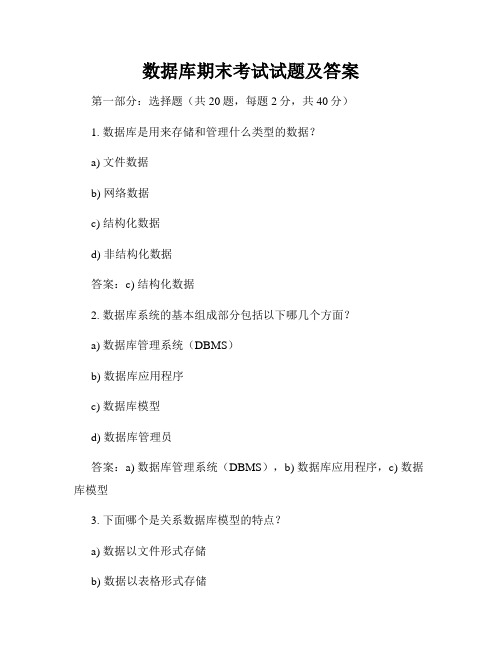
数据库期末考试试题及答案第一部分:选择题(共20题,每题2分,共40分)1. 数据库是用来存储和管理什么类型的数据?a) 文件数据b) 网络数据c) 结构化数据d) 非结构化数据答案:c) 结构化数据2. 数据库系统的基本组成部分包括以下哪几个方面?a) 数据库管理系统(DBMS)b) 数据库应用程序c) 数据库模型d) 数据库管理员答案:a) 数据库管理系统(DBMS),b) 数据库应用程序,c) 数据库模型3. 下面哪个是关系数据库模型的特点?a) 数据以文件形式存储b) 数据以表格形式存储c) 数据以树形结构存储d) 数据以图形结构存储答案:b) 数据以表格形式存储4. 数据库的完整性约束包括以下几种类型?a) 实体完整性b) 参照完整性c) 域完整性d) 属性完整性答案:a) 实体完整性,b) 参照完整性,c) 域完整性,d) 属性完整性5. 数据库事务的ACID特性包括以下哪几个方面?a) 原子性b) 一致性c) 隔离性d) 持久性答案:a) 原子性,b) 一致性,c) 隔离性,d) 持久性6. 关系数据库中,外键用来表示什么类型的关系?a) 一对一关系b) 一对多关系c) 多对多关系d) 多层次关系答案:b) 一对多关系7. 下面哪个是数据库查询语言?a) Javab) C++c) SQLd) HTML答案:c) SQL8. 在数据库中,一个事务的隔离级别有哪几种选择?a) READ COMMITTEDb) REPEATABLE READc) SERIALIZABLEd) READ UNCOMMITTED答案:a) READ COMMITTED,b) REPEATABLE READ,c) SERIALIZABLE,d) READ UNCOMMITTED9. 数据库索引的作用是什么?a) 提高数据访问的速度b) 减少数据存储的空间c) 保证数据的一致性d) 控制数据的权限答案:a) 提高数据访问的速度10. 数据库范式用来做什么?a) 优化数据库查询b) 规范数据库模型c) 压缩数据库存储d) 加密数据库数据答案:b) 规范数据库模型11. 数据库触发器用来做什么?a) 检查数据的有效性b) 定期备份数据库c) 自动执行特定操作d) 创建数据库索引答案:c) 自动执行特定操作12. 数据库备份的作用是什么?a) 保护数据免受损失b) 提高数据库查询速度c) 减少数据存储空间d) 控制数据的权限答案:a) 保护数据免受损失13. 数据库连接是指什么?a) 数据库之间的关系b) 数据库中的数据关系c) 应用程序访问数据库的接口d) 数据库中的表之间的关系答案:c) 应用程序访问数据库的接口14. 数据库主键的作用是什么?a) 提高数据查询速度b) 控制数据的权限c) 唯一标识一条记录d) 加密数据库数据答案:c) 唯一标识一条记录15. 数据库视图是什么?a) 物理存储的数据b) 存储过程c) 虚拟表d) 数据库备份文件答案:c) 虚拟表16. 数据库设计的范式分为几个级别?a) 1NF, 2NF, 3NF, BCNFb) 1NF, 2NF, 3NF, 4NFc) 1NF, 2NF, 3NFd) 1NF, 2NF, 3NF, 5NF答案:b) 1NF, 2NF, 3NF, 4NF17. 数据库连接的类型包括以下哪几种?a) 内连接b) 外连接c) 自连接d) 所有答案都正确答案:d) 所有答案都正确18. 数据库中的事务是?a) 一条SQL语句b) 一组SQL语句c) 一个数据库操作d) 一个用户操作答案:b) 一组SQL语句19. 数据库管理系统(DBMS)的作用是什么?a) 存储和管理数据b) 控制和管理数据库访问c) 进行数据库备份和恢复d) 所有答案都正确答案:d) 所有答案都正确20. 数据库中的事务日志是用来做什么?a) 记录数据库的结构b) 记录数据库的访问权限c) 记录数据库操作的序列d) 记录数据库查询结果答案:c) 记录数据库操作的序列第二部分:填空题(共10题,每题2分,共20分)1. 触发器是通过在数据库中定义______,在特定的数据更新、插入、删除等操作发生时被自动执行。
数据库试题期末考试及答案

数据库试题期末考试及答案数据库期末考试试题一、选择题(每题2分,共20分)1. 数据库管理系统(DBMS)的主要功能是()。
A. 数据存储B. 数据管理C. 数据分析D. 数据加密2. 关系型数据库的存储结构是()。
A. 树形结构B. 网状结构C. 线性结构D. 表格结构3. SQL语言中的“SELECT”语句用于()。
A. 插入数据B. 更新数据C. 查询数据D. 删除数据4. 在关系数据库中,数据的完整性约束包括()。
A. 实体完整性和参照完整性B. 数据完整性和参照完整性C. 实体完整性和用户定义完整性D. 参照完整性和用户定义完整性5. 数据库设计中,范式理论的目的是()。
A. 提高查询效率B. 减少数据冗余C. 增强数据安全性D. 优化存储空间...(此处省略其他选择题,共10题)二、简答题(每题5分,共20分)1. 简述数据库的三级模式结构。
2. 解释什么是事务的ACID属性。
3. 什么是数据库的并发控制?4. 描述什么是数据库的规范化过程。
三、应用题(每题15分,共30分)1. 假设你正在设计一个图书馆管理系统的数据库,请列出至少5个实体,并说明它们之间的关系。
2. 编写一个SQL查询,用于找出所有借阅了超过5本书的读者的姓名和借阅数量。
四、综合题(每题15分,共30分)1. 描述在数据库中实现数据备份和恢复的一般步骤。
2. 给出一个场景,说明如何使用数据库视图来提高数据安全性。
五、论述题(共10分)1. 论述数据库索引在提高查询性能中的作用及其潜在的缺点。
数据库期末考试答案一、选择题答案1. B2. D3. C4. A5. B...(此处省略其他选择题答案)二、简答题答案1. 数据库的三级模式结构包括:外模式(用户视图)、概念模式(逻辑结构)和内模式(存储结构)。
2. 事务的ACID属性包括:原子性(Atomicity)、一致性(Consistency)、隔离性(Isolation)和持久性(Durability)。
《数据库基础与应用(专科必修)》2015期末试题及答案
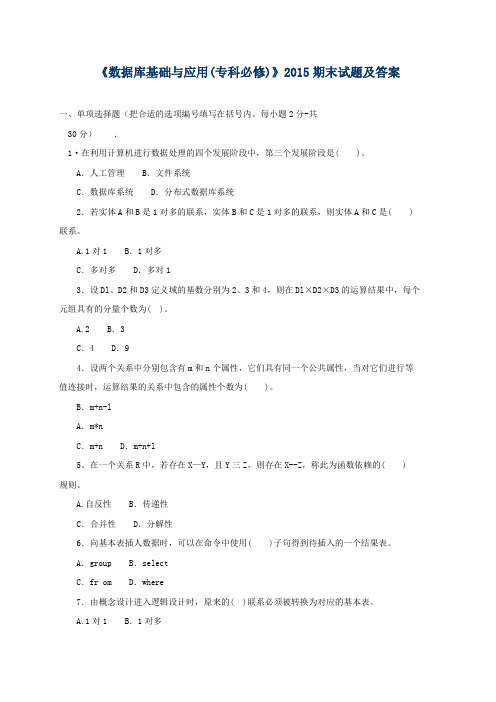
《数据库基础与应用(专科必修)》2015期末试题及答案
一、单项选择题(把合适的选项编号填写在括号内。
每小题2分-共
30分).
1·在利用计算机进行数据处理的四个发展阶段中,第三个发展阶段是( )。
A.人工管理 B.文件系统
C.数据库系统 D.分布式数据库系统
2.若实体A和B是1对多的联系,实体B和C是1对多的联系,则实体A和C是( ) 联系。
A.1对1 B.1对多
C.多对多 D.多对1
3.设Dl、D2和D3定义域的基数分别为2、3和4,则在Dl×D2×D3的运算结果中,每个元组具有的分量个数为( )。
A.2 B.3
C.4 D.9
4.设两个关系中分别包含有m和n个属性,它们具有同一个公共属性,当对它们进行等值连接时,运算结果的关系中包含的属性个数为( )。
B.m+n-l
A.m*n
C.m+n D.m+n+l
5。
在一个关系R中,若存在X—Y,且Y三Z,则存在X--Z,称此为函数依赖的( ) 规则。
A.自反性 B.传递性
C.合并性 D.分解性
6.向基本表插人数据时,可以在命令中使用( )子句得到待插入的一个结果表。
A.group B.select
C.fr om D.where
7.由概念设计进入逻辑设计时,原来的( )联系必须被转换为对应的基本表。
A.1对1 B.1对多。
数据库期末考试试题及答案

数据库期末考试试题及答案一、选择题(每题2分,共20分)1. 在关系数据库中,表与表之间的联系是通过什么实现的?A. 索引B. 主键C. 外键D. 视图答案:C2. SQL语言中,用于查询数据的命令是:A. UPDATEB. INSERTC. SELECTD. DELETE答案:C3. 数据库管理系统(DBMS)的主要功能不包括以下哪一项?A. 数据存储B. 数据查询C. 数据加密D. 数据维护答案:C4. 在数据库中,以下哪个不是数据完整性的类型?A. 实体完整性B. 参照完整性C. 用户完整性D. 域完整性答案:C5. 以下哪个不是数据库设计阶段?A. 需求分析B. 概念设计C. 逻辑设计D. 物理设计答案:A6. 以下哪个是数据库的并发控制技术?A. 锁定B. 索引C. 视图D. 触发器答案:A7. 在SQL中,用于删除表中数据的命令是:A. DROPB. DELETEC. REMOVED. ERASE答案:B8. 数据库的事务具有以下哪个特性?A. 持久性B. 可靠性C. 可用性D. 完整性答案:A9. 在关系数据库中,哪个操作用于添加新的列?A. ALTER TABLEB. CREATE TABLEC. UPDATE TABLED. INSERT INTO答案:A10. 数据库恢复的基础是:A. 日志文件B. 数据字典C. 备份文件D. 索引答案:A二、填空题(每空2分,共20分)11. 数据库管理系统(DBMS)的核心是________。
答案:关系数据库12. 在SQL中,用于插入数据的命令是________。
答案:INSERT INTO13. 数据库的三大范式分别是第一范式(1NF)、第二范式(2NF)和________。
答案:第三范式(3NF)14. 在数据库中,用于更新数据的命令是________。
答案:UPDATE15. 数据库的并发控制主要是为了解决________和________问题。
数据库系统概论期末试题及答案(重点知识)
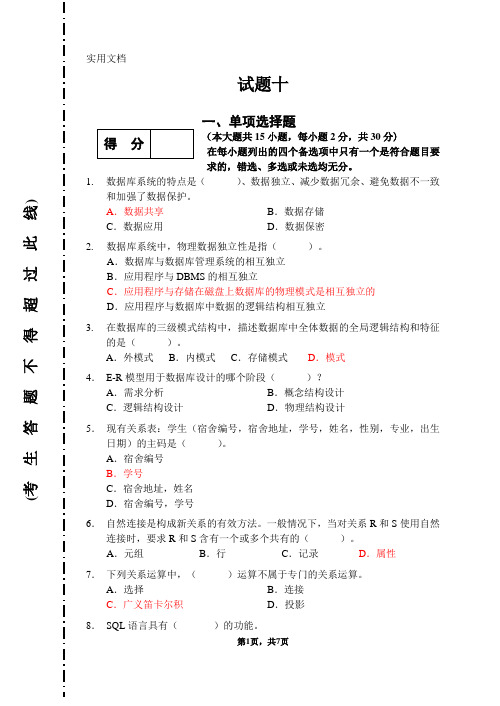
试题十一、单项选择题(本大题共15小题,每小题2分,共30分) 在每小题列出的四个备选项中只有一个是符合题目要 求的,错选、多选或未选均无分。
1. 数据库系统的特点是( )、数据独立、减少数据冗余、避免数据不一致和加强了数据保护。
A .数据共享 B .数据存储 C .数据应用 D .数据保密 2. 数据库系统中,物理数据独立性是指( )。
A .数据库与数据库管理系统的相互独立 B .应用程序与DBMS 的相互独立 C .应用程序与存储在磁盘上数据库的物理模式是相互独立的 D .应用程序与数据库中数据的逻辑结构相互独立 3. 在数据库的三级模式结构中,描述数据库中全体数据的全局逻辑结构和特征的是( )。
A .外模式 B .内模式 C .存储模式 D .模式 4. E-R 模型用于数据库设计的哪个阶段( )? A .需求分析 B .概念结构设计 C .逻辑结构设计 D .物理结构设计 5. 现有关系表:学生(宿舍编号,宿舍地址,学号,姓名,性别,专业,出生日期)的主码是( )。
A .宿舍编号 B .学号 C .宿舍地址,姓名 D .宿舍编号,学号 6. 自然连接是构成新关系的有效方法。
一般情况下,当对关系R 和S 使用自然连接时,要求R 和S 含有一个或多个共有的( )。
A .元组 B .行 C .记录 D .属性 7. 下列关系运算中,( )运算不属于专门的关系运算。
A .选择 B .连接 C .广义笛卡尔积 D .投影 8. SQL 语言具有( )的功能。
(考生答题不得超过此线)A.关系规范化、数据操纵、数据控制B.数据定义、数据操纵、数据控制C.数据定义、关系规范化、数据控制D.数据定义、关系规范化、数据操纵9.如果在一个关系中,存在某个属性(或属性组),虽然不是该关系的主码或只是主码的一部分,但却是另一个关系的主码时,称该属性(或属性组)为这个关系的()A.候选码B.主码C. 外码D. 连接码10.下列关于关系数据模型的术语中,()术语所表达的概念与二维表中的“行”的概念最接近?A.属性B.关系C. 域D. 元组11.假定学生关系是S(S#,SNAME,SEX,AGE),课程关系是C(C#,CNAME,TEACHER),学生选课关系是SC(S#,C#,GRADE)。
2015年春季13秋数据库考试试题B卷
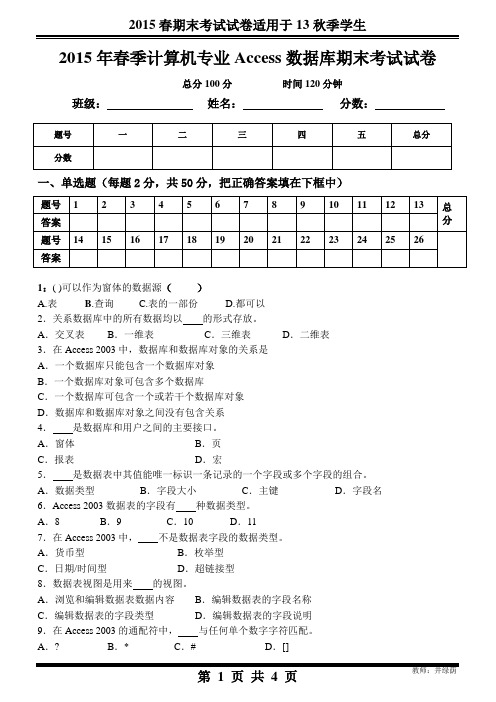
2015年春季计算机专业Access 数据库期末考试试卷总分100分 时间120分钟班级: 姓名: 分数:一、单选题(每题2分,共50分,把正确答案填在下框中)1:( )可以作为窗体的数据源( )A.表 B .查询 C.表的一部份 D.都可以 2.关系数据库中的所有数据均以 的形式存放。
A.交叉表B .一维表C .三维表D .二维表3.在Access 2003中,数据库和数据库对象的关系是 A .一个数据库只能包含一个数据库对象B .一个数据库对象可包含多个数据库C .一个数据库可包含一个或若干个数据库对象D .数据库和数据库对象之间没有包含关系 4. 是数据库和用户之间的主要接口。
A .窗体 B .页 C .报表D .宏5. 是数据表中其值能唯一标识一条记录的一个字段或多个字段的组合。
A .数据类型B .字段大小C .主键D .字段名6.Access 2003数据表的字段有 种数据类型。
A .8B .9C .10D .117.在Access 2003中, 不是数据表字段的数据类型。
A .货币型B .枚举型C .日期/时间型D .超链接型8.数据表视图是用来 的视图。
A .浏览和编辑数据表数据内容 B .编辑数据表的字段名称 C .编辑数据表的字段类型D .编辑数据表的字段说明9.在Access 2003的通配符中, 与任何单个数字字符匹配。
A .?B .*C .#D .[]10.按降序排序,速度、加速度、时间和距离的排序结果是A.时间、速度、距离、加速度B.速度、时间、加速度、距离C.时间、速度、加速度、距离D.速度、时间、距离、加速度11.在Access 2003中,操作查询包含4种类型。
A.生成表查询、简单查询、更新查询、参数查询B.生成表查询、追加查询、更新查询、删除查询C.简单查询、更新查询、参数查询、追加查询D.追加查询、更新查询、删除查询、简单查询12.使用查询不仅可以创建新的查询,还可以对已存在的查询进行修改和编辑。
2015数据库系统期末试题及答案
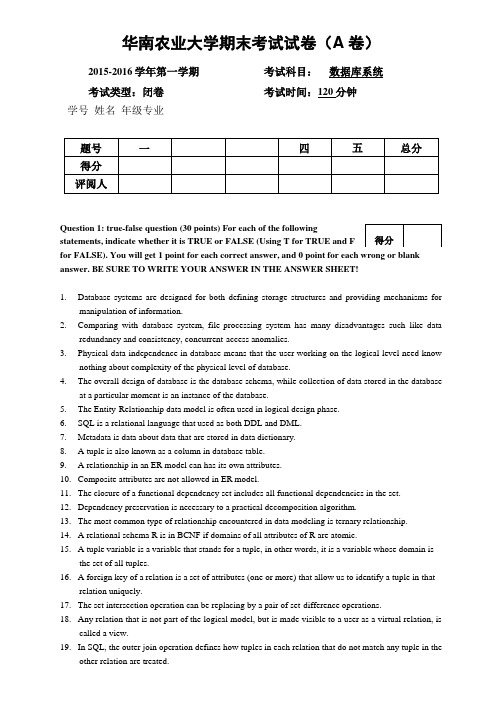
华南农业大学期末考试试卷(A 卷)2015-2016学年第一学期考试科目: 数据库系统 考试类型:闭卷 考试时间:120 分钟学号 姓名 年级专业Question 1: true-false question (30 points) For each of the followingstatements, indicate whether it is TRUE or FALSE (Using T for TRUE and F for FALSE). You will get 1 point for each correct answer, and 0 point for each wrong or blankanswer. BE SURE TO WRITE YOUR ANSWER IN THE ANSWER SHEET!1. Database systems are designed for both defining storage structures and providing mechanisms formanipulation of information.2. Comparing with database system, file-processing system has many disadvantages such like dataredundancy and consistency, concurrent-access anomalies.3. Physical data independence in database means that the user working on the logical level need knownothing about complexity of the physical level of database.4. The overall design of database is the database schema, while collection of data stored in the databaseat a particular moment is an instance of the database.5. The Entity-Relationship data model is often used in logical design phase.6. SQL is a relational language that used as both DDL and DML.7. Metadata is data about data that are stored in data dictionary.8. A tuple is also known as a column in database table.9. A relationship in an ER model can has its own attributes. 10. Composite attributes are not allowed in ER model.11. The closure of a functional dependency set includes all functional dependencies in the set. 12. Dependency preservation is necessary to a practical decomposition algorithm.13. The most common type of relationship encountered in data modeling is ternary relationship. 14. A relational schema R is in BCNF if domains of all attributes of R are atomic.15. A tuple variable is a variable that stands for a tuple, in other words, it is a variable whose domain isthe set of all tuples.16. A foreign key of a relation is a set of attributes (one or more) that allow us to identify a tuple in thatrelation uniquely.17. The set intersection operation can be replacing by a pair of set-difference operations.18. Any relation that is not part of the logical model, but is made visible to a user as a virtual relation, iscalled a view.19. In SQL, the outer join operation defines how tuples in each relation that do not match any tuple in theother relation are treated.20.The main database design phase includes requirement analysis, logical-design and coding phase.21.The concept “relation” in relation model is exactly the same as the concept “entity” in ERmodel.22. A weak entity set cannot participate in relationships like usual entity sets.23. A functional dependency a—0 is trivial if pea.24.Armstrong's axioms are used to calculate the closures of attribute sets.25.Once a transaction is defined, it must be at active, partially committed, failed, aborted or committedstate.26.Serial executions of transaction can improve throughput and resource utilization while add waitingtime.27. A schedule is correct if it is conflict equivalent to a serial schedule, that means it is a serializableschedule.28.2-Phase Locking Protocol ensures serializability and can avoid dead lock.29.In recovery technology, Log must be written before updating is written into database.30.Checkpoint is defined to simplify recovery when a system corruption is occurred.Question 2 single-choice question (2 points for each, and 30 points in total) BE SURE TO WRITE1.Assume R(a, b) and S(b, c) are two relations.Q1: = D,(R S), and Q2: = n ac(R x S)Which of the followings is correct?A.Q1 and Q2 produce the same answer.B.The answer to Q1 is always contained in the answer to Q2.C.The answer to Q2 is always contained in the answer to Q1.D.Q1 and Q2 produce completely different answers.2.Choose the only one correct expression from the followings: ________A. (<> some)三inB. (= all)三not inC. (<> all)三not inD. (= some)三not in3.Let R(x) be the schema of relation R.Q1: SELECT DISTINCT(x) FROM R rrWHERE NOT EXISTS(SELECT * FROM R WHERE x>rr.x);Q2: SELECT MAX(x) FROM R;Then _______ is correct.A.Q1 and Q2 produce the same answer.B.The answer to Q1 is always contained in the answer to Q2.C.The answer to Q2 is always contained in the answer to Q1.D.Q1 and Q2 produce different answers.4.In SQL, a DELETE statement without a WHERE clause:A. delete all data in the table.B. drop the table.C. delete one column in a table.D. Results in a Cartesian product.5.Mapping an E-R diagram into relation schemas can happen in the phase of _______ .A. requirement analysisB. logical designC. conceptual designD. physical design6.If the mapping cardinality from entity set S to entity set T is m-n, then an entity of T isassociated with ____ entity(entities) of S.A. oneB. at most oneC. at least oneD. none of A,B,C is correct7. Let R(A,B,C,D) be a relation schema, and A ^B, C f D, then is wrong. A. AC -BDB. AC -RC. AD -BD. AD f BC8. Let R(A,B,C,D,E) be a relation schema, from the functional dependency set F={A f B, BC -D, C -E}, we can infer that _____________ . A. AC is a candidate key of R B. BC is a candidate key of R C. CD is a super key of RD. none of the above9. Relation among Normal Form is ___________ A. 1NFu 3NF uBCNF B. 3NFu 1NF uBCNF C. BCNFu 3NF u1NF D. 1NFu BCNF u3NF10. Choose the proper choice to make the following query to realize: Find the names of all customers whose street includes the substring “Main”.select customer_namefrom customer where customer_streetA. like 'Main '%'B. like …_Main_'C. like …\Main_'D. like …%Main%'11. Suppose the relation R(A,B,C) has the following four tuples:Which of the following functional dependencies does not hold in R?A. A->BB. BC->AC. C->BD. AB->A12. The main purpose of transaction management is to deal with _________ p roblem(s). A. Concurrency B. Failure C. Memory crash D. both A and B13. If <T i start> and <T i commit> has appeared in the log after the nearest checkpoint to system crash, then transaction T i must be _____________ when system recovery. A. undone B. redone C. deleted D. Neither A or B14. If a transaction T i has obtain an shared lock on data item A, then transition T j cannotA. obtain an exclusive lock on data item AB. obtain a shared lock on data item BC. obtain an exclusive lock on data item BD. obtain an shared lock on data item A15. in 2PL protocol, at ________ stage, A transaction may not obtain locks, but can release locks.A. Growing phaseB. Shrinking phaseC. CommittedD. Aborted Question 3 (13 points) Consider the following database requirement: A laboratory has properties like ID, name, location, rank. A researcher has properties like ID, name, age, skill. A research project has properties like ID,name, budget, and year. The above three entities must satisfy some constraints: Each researcher can be unemployed or employed by one laboratory. One laboratory can employ many researchers. And a researcher can only work at a laboratory at a time. If a researcher is employed, his salaryneeds to be recorded in the database. A laboratory can participate many projects and a project can be shared by many laboratories.(1) Draw ER diagram to illustrate the requirements. And you can make and state necessary assumptions if any. [6 points](2) Translate your ER diagram into relational database schemas, underline primary keys of each relation, and label foreign keys if it has. Be sure using different way to mark primary keys and foreign keys. [4 points](3) write an sql sentence to create table to store information about which project has been shared by which labs. [3 points]Question 4. (16 points) Consider the relational database of a banking enterprise with the following relation schemas, where the primary keys are underlined.branch (branch name, branch_city, assets)customer (customer name, customer_street, customer_city) loan (loan number, branch_name, amount) borrower (customer name, loan number) account (account number, branch_name, balance) depositor (customer name, account number)Give an expression in SQL or in relational algebra expression for each of the following queries. 1) To find all loan number for loans made at the Perryridge branch (that is the name of a certain branch) with loan amounts greater than $1000 in SQL and relational algebra . [4 points]2) Find all customers who have both a loan and an account using relational algebra expression . [3 points]3) Find name of all customers who have at least one loan that the values for amount is null. In SQL [3 points]4) Find the names of all branches where the average account balance is more than $1000 in SQL . [3 points]5) Find all customers that live in the same city with branches they open accounts in SQL. [3 points] Question 5 (11 points) Consider a relation R(A, B, C, D, E) with the set of Functional DependenciesF = { A f BD, BC f E, B f D, D f A }1) Give all candidate keys of R. [4 points] 2) Give a canonical cover of F. [3 points]3) Is R in 3NF? explain why if it is or decompose it into 3NF if not.[4 points]华南农业大学期末考试试卷(A 卷-Answer Sheets )得分and F for FALSE). You will get 1 point for each correct answer, and 0 point for each wrong or blank answer. BE SURE TO WRITE YOUR ANSWER IN THE ANSWER SHEET!题号 1 2 3 4 5 6 7 8 9 10 11 12 13 14 15 得分 T F T T F T T F T F T F F F T 题号16 17 18 19 20 21 22 23 24 25 26 27 28 29 30 得分FTTTFFFTFTFTFTTQuestion 3 (13 points) (ANSWER IN NOT UNIQUE )(1) Draw ER diagram to illustrate the requirements. And you can make and state necessary assumptions if any. [6 points] (next page)(2) Translate your ER diagram into relational database schemas, underline primary keys of each relation, and label foreign keys if it has. Be sure using different way to mark primary keys and foreign keys. [4 points]Laboratory (ID^Name, Location,rank)Researcher (ID, Name, birthday, skill, hiretime, salary, lab id) project ( ID, name, budget, year)participate (proj id, lab id, proj_lab_budget, proj_lab_year)Here primary key is underlined, and foreign key is underlined by wavy line.(3) write an sql sentence to create table to store information about which project has been shared by which labs. [3 points]Create table participate (proj_id int,得分题号 1 2 3 4 5 6 7 8 9 10 11 12 13 14 15 得分B C A A B D D A C D B D B A BQuestion 2 single-choice question (30 points, and 2 for each) BESURE TO WRITE YOUR ANSWER IN THE ANSWER SHEET!2015-2016学年第1学期考试科目:Database systemQuestion 1: true-false question (30 points) For each of the followingstatements, indicate whether it is TRUE or FALSE (Using T for TRUEloan_number branch_name=' Perryridge branch' and amount>1000 ( loan)lab_id int, proj_lab_budget real(10,2), proj_lab_year intprimary key (proj_id, lab_id),foreign key proj_id reference project(id), foreign key lab_id reference laboratory(id))Question 4. (16 points) Consider the relational database of a banking enterprise with the following relation schemas, where the primary keys are underlined.branch (branch name, branch_city, assets)customer (customer name, customer_street, customer_city)loan (loan number, branch_name, amount)borrower (customer name, loan number)account (account number, branch_name, balance)depositor (customer name, account number)Give an expression in SQL or in relational algebra expression for each of the following queries. (ANSWER IN NOT UNIQUE )1)To find all loan number for loans made at the Perryridge branch (that is the name of a certain branch) with loan amounts greater than $1000 in SQL and relational algebra. [4 points]Select loan_number from loan where branch_name=' Perryridge branch' andamount>10002)Find all customers who have both a loan and an account using relational algebra expression. [3 points](borrower IV| depositor) customer_name1. ER diagram as follows:3)Find name of all customers who have at least one loan that the values for amountis null. In SQL [3 points]Select distinct customer_name from loan where amount is null4)Find the names of all branches where the average account balance is more than $1000 in SQL. [3 points]Select branch_name from account group by branch_name having avg(balance)>10005)Find all customers that live in the same city with branches they open accounts in SQL.[3 points]Select customer_name, customer_city from ((customer natural join depositor) natural join account) natural join branch where customer_city= branch_cityQuestion 5 (11 points) Consider a relation R(A, B, C, D, E) with the set of Functional DependenciesF = { A - BD, BC - E, B - D, D - A }1)Give all candidate keys of R. [4 points]AC,BC, DC2)Give a canonical cover of F. [3 points] (ANSWER IN NOT UNIQUE )F c = { A - B, BC - E, B 一D, D - A }3)Is R in 3NF? explain why if it is or decompose it into 3NF if not. [4 points] (ANSWERIN NOT UNIQUE )No,decompose it into {R1(AB), R2(BCE),r3(BD),R4(DA)}。
数据库系统期末考试试题答案
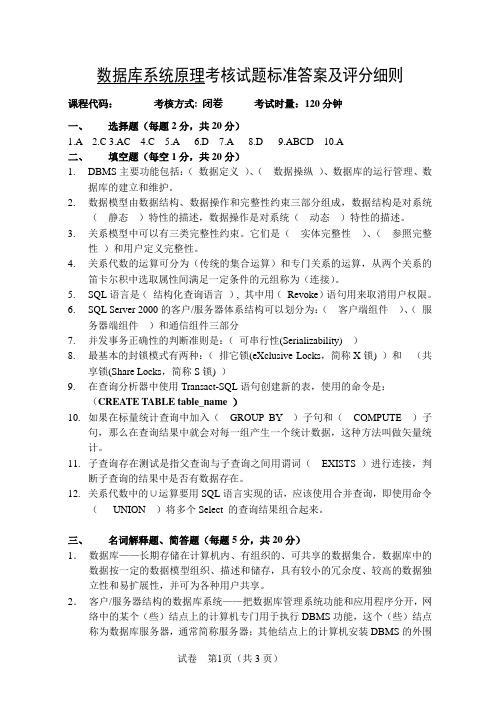
数据库系统原理考核试题标准答案及评分细则课程代码:考核方式: 闭卷考试时量:120分钟一、选择题(每题2分,共20分)1.A2.C3.AC4.C5.A6.D7.A8.D9.ABCD 10.A二、填空题(每空1分,共20分)1.DBMS主要功能包括:(数据定义)、(数据操纵)、数据库的运行管理、数据库的建立和维护。
2.数据模型由数据结构、数据操作和完整性约束三部分组成,数据结构是对系统(静态)特性的描述,数据操作是对系统(动态)特性的描述。
3.关系模型中可以有三类完整性约束。
它们是(实体完整性)、(参照完整性)和用户定义完整性。
4.关系代数的运算可分为(传统的集合运算)和专门关系的运算,从两个关系的笛卡尔积中选取属性间满足一定条件的元组称为(连接)。
5.SQL语言是(结构化查询语言), 其中用(Revoke)语句用来取消用户权限。
6.SQL Server 2000的客户/服务器体系结构可以划分为:(客户端组件)、(服务器端组件)和通信组件三部分7.并发事务正确性的判断准则是:(可串行性(Serializability) )8.最基本的封锁模式有两种:(排它锁(eXclusive Locks,简称X锁) )和(共享锁(Share Locks,简称S锁) )9.在查询分析器中使用Transact-SQL语句创建新的表,使用的命令是:(CREATE TABLE table_name )10.如果在标量统计查询中加入(GROUP BY )子句和(COMPUTE )子句,那么在查询结果中就会对每一组产生一个统计数据,这种方法叫做矢量统计。
11.子查询存在测试是指父查询与子查询之间用谓词(EXISTS )进行连接,判断子查询的结果中是否有数据存在。
12.关系代数中的∪运算要用SQL语言实现的话,应该使用合并查询,即使用命令(UNION )将多个Select 的查询结果组合起来。
三、名词解释题、简答题(每题5分,共20分)1.数据库——长期存储在计算机内、有组织的、可共享的数据集合。
《数据库系统》期末试卷及答案

《数据库系统》期末试卷及答案一、填空题1.数据库管理系统(DBMS)通常提供__数据定义__、数据操纵、数据控制和数据库维护。
2.数据库保护问题包括:__安全性__、完整性、故障恢复和并发控制等多方面。
3.关系代数中专门的关系运算包括:选择、__查询__、连接和除法。
4.数据库中常用的四种文件组织方式是:顺序文件、索引文件、__散列文件__、倒排文件。
5.一个数据库系统应由计算机硬件、数据库、应用软件、__数据库管理系统__、__数据库管理员__等5部分构成。
6、数据库发展经历了手工管理数据阶段、文件管理阶段、__数据库系统阶段__7.数据库的逻辑模型设计阶段,任务是将总体E-R模型转换成__关系模型__。
8.当数据库被破坏后,如果事先保存了日志文件和__数据库的副本__,就有可能恢复数据库。
9.实体完整性规则要求主码取值 __唯一且不为空__。
二、单项选择题1.要保证数据库物理数据独立性,需要修改的是( B )。
A.模式B.模式与内模式的映射C.模式与外模式的映射D.内模式2.数据库系统与文件系统的主要区别是( B )A.数据库系统复杂,而文件系统简单B.文件系统不能解决数据冗余和数据独立性问题,而数据库系统可以解决C.文件系统只能管理程序文件,而数据库系统能够管理各种类型的文件D.文件系统管理的数据量较少,而数据库系统可以管理庞大的数据量3. 在一个关系中,能够惟一确定一条元组的属性组合叫做( D )A.索引码B.外码C.域D.主码4. 下列四项中,不属于数据库特点的是 ( C )。
A.数据共享B.数据完整性C.数据冗余很高D.数据独立性高5. 数据库中存储的是( D )。
A.数据B.数据模型C.数据之间的联系D.数据以及数据之间的联系6. 反映现实世界中实体及实体间联系的信息模型是( D )。
A.关系模型B.层次模型C.网状模型D.E-R模型7.基本SQL语言可以创建的内容中,不包括( C )。
山西大学2015级《数据库系统》答案
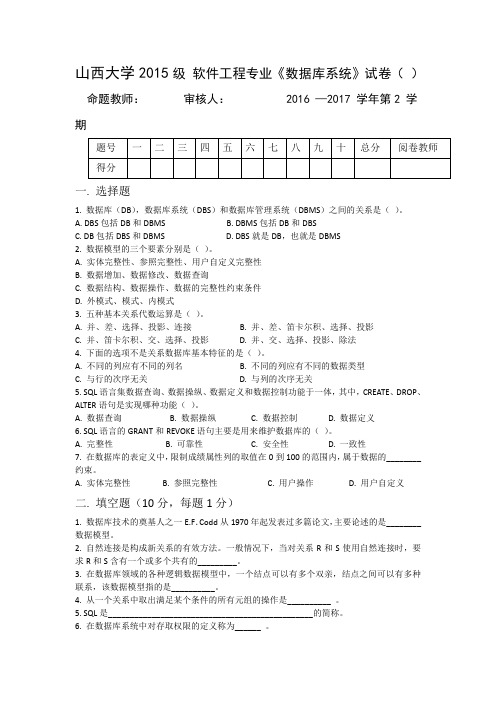
山西大学2015级软件工程专业《数据库系统》试卷()命题教师:审核人: 2016 —2017 学年第2 学期一. 选择题1. 数据库(DB),数据库系统(DBS)和数据库管理系统(DBMS)之间的关系是()。
A. DBS包括DB和DBMSB. DBMS包括DB和DBSC. DB包括DBS和DBMSD. DBS就是DB,也就是DBMS2. 数据模型的三个要素分别是()。
A. 实体完整性、参照完整性、用户自定义完整性B. 数据增加、数据修改、数据查询C. 数据结构、数据操作、数据的完整性约束条件D. 外模式、模式、内模式3. 五种基本关系代数运算是()。
A. 并、差、选择、投影、连接B. 并、差、笛卡尔积、选择、投影C. 并、笛卡尔积、交、选择、投影D. 并、交、选择、投影、除法4. 下面的选项不是关系数据库基本特征的是()。
A. 不同的列应有不同的列名B. 不同的列应有不同的数据类型C. 与行的次序无关D. 与列的次序无关5. SQL语言集数据查询、数据操纵、数据定义和数据控制功能于一体,其中,CREATE、DROP、ALTER语句是实现哪种功能()。
A. 数据查询B. 数据操纵C. 数据控制D. 数据定义6. SQL语言的GRANT和REVOKE语句主要是用来维护数据库的()。
A. 完整性B. 可靠性C. 安全性D. 一致性7. 在数据库的表定义中,限制成绩属性列的取值在0到100的范围内,属于数据的________约束。
A. 实体完整性B. 参照完整性C. 用户操作D. 用户自定义二. 填空题(10分,每题1分)1. 数据库技术的奠基人之一E.F.Codd从1970年起发表过多篇论文,主要论述的是________数据模型。
2. 自然连接是构成新关系的有效方法。
一般情况下,当对关系R和S使用自然连接时,要求R和S含有一个或多个共有的_________。
3. 在数据库领域的各种逻辑数据模型中,一个结点可以有多个双亲,结点之间可以有多种联系,该数据模型指的是__________。
- 1、下载文档前请自行甄别文档内容的完整性,平台不提供额外的编辑、内容补充、找答案等附加服务。
- 2、"仅部分预览"的文档,不可在线预览部分如存在完整性等问题,可反馈申请退款(可完整预览的文档不适用该条件!)。
- 3、如文档侵犯您的权益,请联系客服反馈,我们会尽快为您处理(人工客服工作时间:9:00-18:30)。
华南农业大学期末考试试卷(A 卷)2015-2016学年第一学期 考试科目: 数据库系统 考试类型:闭卷 考试时间: 120 分钟 学号 姓名 年级专业Question 1: true-false question (30 points) For each of the followingstatements, indicate whether it is TRUE or FALSE (Using T for TRUEand F for FALSE). You will get 1 point for each correct answer, and 0 point for each wrong or blank answer. BE SURE TO WRITE YOUR ANSWER IN THE ANSWER SHEET!1. Database systems are designed for both defining storage structures and providing mechanismsfor manipulation of information.2. Comparing with database system, file-processing system has many disadvantages such likedata redundancy and consistency, concurrent-access anomalies.3. Physical data independence in database means that the user working on the logical level needknow nothing about complexity of the physical level of database.4. The overall design of database is the database schema, while collection of data stored in thedatabase at a particular moment is an instance of the database.5. The Entity-Relationship data model is often used in logical design phase.6. SQL is a relational language that used as both DDL and DML.7. Metadata is data about data that are stored in data dictionary.8. A tuple is also known as a column in database table.9. A relationship in an ER model can has its own attributes. 10. Composite attributes are not allowed in ER model.11. The closure of a functional dependency set includes all functional dependencies in the set. 12. Dependency preservation is necessary to a practical decomposition algorithm.13. The most common type of relationship encountered in data modeling is ternary relationship. 14. A relational schema R is in BCNF if domains of all attributes of R are atomic.15. A tuple variable is a variable that stands for a tuple, in other words, it is a variable whosedomain is the set of all tuples.16. A foreign key of a relation is a set of attributes (one or more) that allow us to identify a tuplein that relation uniquely.17. The set intersection operation can be replacing by a pair of set-difference operations. 18. Any relation that is not part of the logical model, but is made visible to a user as a virtualrelation, is called a view.19. In SQL, the outer join operation defines how tuples in each relation that do not match anytuple in the other relation are treated.20. The main database design phase includes requirement analysis, logical-design and codingphase.21. The concept “relation” in relation model is exactly the same as the concept “entity ” in ERmodel.22. A weak entity set cannot participate in relationships like usual entity sets.23. A functional dependency α→β is trivial if β ⊆ α.24. Armstrong‟s axioms are used to calculate the closures of attribute sets.25. Once a transaction is defined, it must be at active, partially committed, failed, aborted orcommitted state.26. Serial executions of transaction can improve throughput and resource utilization while addwaiting time.27. A schedule is correct if it is conflict equivalent to a serial schedule, that means it is aserializable schedule.28. 2-Phase Locking Protocol ensures serializability and can avoid dead lock.29. In recovery technology, Log must be written before updating is written into database. 30. Checkpoint is defined to simplify recovery when a system corruption is occurred.Question 2 single-choice question (2 points for each, and 30 points in total) BE SURE TO WRITE YOUR ANSWER IN HE ANSWER SHEET!1. Assume R(a, b) and S(b, c) are two relations.Q1: =()S R c a ,∏, and Q2: =)(,S R c a ⨯∏Which of the followings is correct? A. Q1 and Q2 produce the same answer.B. The answer to Q1 is always contained in the answer to Q2.C. The answer to Q2 is always contained in the answer to Q1.D. Q1 and Q2 produce completely different answers.2. Choose the only one correct expression from the followings: _______.A. (<> some) ≡ inB. (= all) ≡ not inC. (<> all) ≡ not inD. (= some) ≡ not in 3. Let R(x) be the schema of relation R.Q1: SELECT DISTINCT(x) FROM R rrWHERE NOT EXISTS(SELECT * FROM R WHERE x>rr.x); Q2: SELECT MAX(x) FROM R; Then _______ is correct.A. Q1 and Q2 produce the same answer.B. The answer to Q1 is always contained in the answer to Q2.C. The answer to Q2 is always contained in the answer to Q1.D. Q1 and Q2 produce different answers.4. In SQL, a DELETE statement without a WHERE clause: A. delete all data in the table. B. drop the table.C. delete one column in a table.D. Results in a Cartesian product.5. Mapping an E-R diagram into relation schemas can happen in the phase of ______. A. requirement analysis B. logical design C. conceptual design D. physical design6. If the mapping cardinality from entity set S to entity set T is m-n, then an entity of T isassociated with ____ entity(entities) of S.A. oneB. at most oneC. at least oneD. none of A,B,C is correct7. Let R(A,B,C,D) be a relation schema, and A →B, C →D, then_____ is wrong. A. AC →BD B. AC →R C. AD →B D. AD →BC8. Let R(A,B,C,D,E) be a relation schema, from the functional dependency set F={A →B, BC →D, C →E}, we can infer that_____. A. AC is a candidate key of R B. BC is a candidate key of R C. CD is a super key of R D. none of the above 9. Relation among Normal Form i sA. 1NF ⊂ 3NF ⊂BCNFB. 3NF ⊂ 1NF ⊂BCNFC. BCNF ⊂ 3NF ⊂1NFD. 1NF ⊂ BCNF ⊂3NF10. Choose the proper choice to make the following query to realize:Find the nam es of all customers whose street includes the substring “Main”.select customer_name from customer where customer_street __________ A. like …Main \%‟ B. like …_Main_‟ C. like …\Main_‟ D. like …%Main%‟Which of the following functional dependencies does not hold in R? A. A->B B. BC->A C. C->B D. AB->A12. The main purpose of transaction management is to deal with _______ problem(s). A. Concurrency B. Failure C. Memory crash D. both A and B13. If <T i start> and <T i commit> has appeared in the log after the nearest checkpoint to system crash, then transaction T i must be ______ when system recovery. A. undone B. redoneC. deletedD. Neither A or B14. If a transaction T i has obtain an shared lock on data item A, then transition T j cannot ______.A. obtain an exclusive lock on data item AB. obtain a shared lock on data item BC. obtain an exclusive lock on data item BD. obtain an shared lock on data item A15. in 2PL protocol, at stage, A transaction may not obtain locks, but can release locks.A. Growing phaseB. Shrinking phaseC. CommittedD. AbortedQuestion 3 (13 points) Consider the following database requirement:A laboratory has properties like ID, name, location, rank. A researcher hasproperties like ID, name, age, skill. A research project has properties like ID,name, budget, and year. The above three entities must satisfy some constraints: Each researcher can be unemployed or employed by one laboratory. One laboratory can employ many researchers. And a researcher can only work at a laboratory at a time. If a researcher is employed, his salaryneeds to be recorded in the database. A laboratory can participate many projects and a project can be shared by many laboratories.(1) Draw ER diagram to illustrate the requirements. And you can make and state necessary assumptions if any. [6 points](2) Translate your ER diagram into relational database schemas, underline primary keys of each relation, and label foreign keys if it has. Be sure using different way to mark primary keys and foreign keys. [4 points](3) write an sql sentence to create table to store information about which project has been shared by which labs. [3 points]Question 4. (16 points) Consider the relational database of a banking enterprise with the following relation schemas, where the primary keys are underlined.branch (branch_name, branch_city, assets)customer (customer_name, customer_street, customer_city)loan (loan_number, branch_name, amount) borrower (customer_name, loan_number)account (account_number, branch_name, balance) depositor (customer_name, account_number)Give an expression in SQL or in relational algebra expression for each of the following queries. 1) To find all loan number for loans made at the Perryridge branch (that is the name of a certain branch) with loan amounts greater than $1000 in SQL and relational algebra . [4 points]2) Find all customers who have both a loan and an account using relational algebra expression . [3 points]3) Find name of all customers who have at least one loan that the values for amount is null. In SQL [3 points]4) Find the names of all branches where the average account balance is more than $1000 in SQL . [3 points]5) Find all customers that live in the same city with branches they open accounts in SQL. [3 points]Question 5 (11 points) Consider a relation R(A, B, C, D, E) with the set of Functional DependenciesF = { A → BD, BC → E, B → D, D → A }1) Give all candidate keys of R. [4 points] 2) Give a canonical cover of F. [3 points]3) Is R in 3NF? explain why if it is or decompose it into 3NF if not. [4 points]华南农业大学期末考试试卷(A 卷-Answer Sheets )2015-2016学年第1 学期 考试科目: Database system 考试类型:(闭卷) 考试时间: 120 分钟 学号 姓名 年级专业Question 1: true-false question (30 points) For each of the followingstatements, indicate whether it is TRUE or FALSE (Using T for TRUEand F for FALSE). You will get 1 point for each correct answer, and 0 point for each wrong or blank answer. BE SURE TO WRITE YOUR ANSWER IN THE ANSWER SHEET!Question 2 single-choice question (30 points, and 2 for each)BE SURE TO WRITE YOUR ANSWER IN THE ANSWER SHEET!Question 3 (13 points) (ANSWER IN NOT UNIQUE )(1) Draw ER diagram to illustrate the requirements. And you can make and state necessary assumptions if any. [6 points] (next page)(2) Translate your ER diagram into relational database schemas, underline primary keys of each relation, and label foreign keys if it has. Be sure using different way to mark primary keys and foreign keys. [4 points] Laboratory (ID, Name, Location,rank)Researcher (ID, Name, birthday, skill, hiretime, salary, lab_id) project ( ID, name, budget, year)participate (proj_id, lab_id, proj_lab_budget, proj_lab_year)Here primary key is underlined, and foreign key is underlined by wavy line.(3) write an sql sentence to create table to store information about which project has been shared by which labs. [3 points] Create table participate (proj_id int,lab_id int, proj_lab_budget real(10,2),proj_lab_year intprimary key (proj_id, lab_id),foreign key proj_id reference project(id),foreign key lab_id reference laboratory(id))Question 4. (16 points) Consider the relational database of a banking enterprise with the following relation schemas, where the primary keys are underlined.branch (branch_name, branch_city, assets)customer (customer_name, customer_street, customer_city)loan (loan_number, branch_name, amount)borrower (customer_name, loan_number)account (account_number, branch_name, balance)depositor (customer_name, account_number)Give an expression in SQL or in relational algebra expression for each of the following queries. (ANSWER IN NOT UNIQUE )1)To find all loan number for loans made at the Perryridge branch (that is the name of a certain branch) with loan amounts greater than $1000in SQL and relational algebra. [4 points]Select loan_number from loan where branch_name=‟Perryridge branch‟ and amount>1000∏ loan_numberσbranch_name=‟ Perryridge branch‟ and amount>1000 ( loan)2)Find all customers who have both a loan and an account using relational algebra expression. [3 points]customer_name ( borrower d epositor)3)Find name of all customers who have at least one loan that the values for amount is null. In SQL [3 points]Select distinct customer_name from loan where amount is null4)Find the names of all branches where the average account balance is more than $1000 in SQL. [3 points]Select branch_name from account group by branch_name having avg(balance)>10005) Find all customers that live in the same city with branches they open accounts in SQL. [3 points]Select customer_name, customer_city from ((customer natural join depositor) natural join account) natural join branch where customer_city= branch_cityQuestion 5 (11 points) Consider a relation R(A, B, C, D, E) with the set of Functional DependenciesF = { A →BD, BC →E, B →D, D →A }1)Give all candidate keys of R. [4 points]AC,BC, DC2)Give a canonical cover of F. [3 points] (ANSWER IN NOT UNIQUE )F c = { A →B, BC →E, B →D, D →A }3)Is R in 3NF? explain why if it is or decompose it into 3NF if not. [4 points](ANSWER IN NOT UNIQUE )No,decompose it into {R1(AB), R2(BCE),r3(BD),R4(DA)}。
